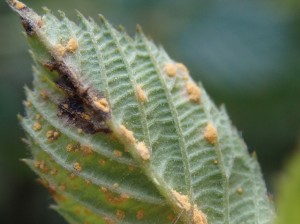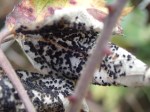Blackberry is one of the worst weeds in our district particularly in terms of its environmental impact, with its tendency to out-compete and choke native vegetation, and reduce habitat quality for native animals (e.g. restrict the movement of Koalas) . By law all landholders are required to make reasonable efforts to keep Blackberries under control. Where blackberries can be readily accessed conventional methods such as spraying with herbicides are still the recommended way to keep Blackberries in check.

The development and release several years ago of new strains of Blackberry Leaf Rust may work as an additional tool to help the overall battle against this weed. It is hoped that these new strains are more vigorous and have more of a negative impact on Blackberry growth. Blackberry Leaf Rust spreads by spores which are carried in the wind and it is thought that they can spread long distances. Their ability to spread should mean that after the initial introduction they should disperse out by themselves into sites that have suitable conditions for their growth. (It is impossible to tell by sight whether or not the rust you are looking at are the new strains of rust or the original ones).

Blackberry rust mainly impacts on fresh new growth and has less impact on older canes and leaves. The rust can cause leaves on new growth to curl up and die, preventing the tips of new stems from taking root and spreading. The damage the rust does to the plant can seem spectacular but it may take many years of repeated rust attacks to have a real impact on the Blackberry spread. There is hope however that the in the longer term the impact of the rust on the blackberry foliage can allow more opportunity for native plants to grow and re-establish in areas where Blackberry is currently thriving.
The rust is not tolerant of drought or hot dry conditions, sites where the rust does best tend to be higher rainfall areas (e.g > 750mm per annum) that have part shade and protection from drying winds. It will also persist better in sites that have larger infestations of Blackberry, meaning that where smaller patches exist every effort should be make to remove them by other methods. The best time to see the impact that rust may be having on your site is early autumn.















